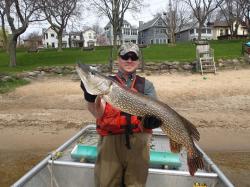Wisconsin Offers Tips on Spring Inland Season Opening May 7
from The Fishing Wire
MADISON, Wis. – Warming temperatures throughout Wisconsin this week should make for a great bite when the general inland fishing season gets underway on Saturday, May 7.
DNR southern fisheries supervisor David Rowe holds a northern pike netted during a musky survey on Lake Monona in Dane County.
Photo Credit: DNR

Matt Andre with big catfish
Lake Wissota, a 6,300 acre impoundment of the Chippewa River, is well known for its trophy musky. However, the catfish fishery has been gaining popularity and during the spring 2016 fisheries survey, flathead catfish over 20 pounds were a frequent occurrence with flatheads over 40 pounds not uncommon – including this one held by fisheries technician Matt Andre.
Photo Credit: DNR

David Rowe holds a northern pike

Joseph Gerbyshak holds two 7-plus pound walleyes
DNR fisheries biologist Joseph Gerbyshak holds two 7-plus pound walleyes from Long Lake in northern Chippewa County. The lake’s walleye population is rebounding according to recent fisheries survey data and now totals 3.6 adult walleye per acre, up from 2.9 adult walleye per acre four years ago.
Photo Credit: DNR
Justine Hasz, fisheries director for the Wisconsin Department of Natural Resources, said spring survey work on lakes and rivers around Wisconsin indicates healthy fish populations and great opportunities for anglers based on the walleye, bass, northern pike, panfish, trout, muskies and even catfish netted and promptly released by fisheries crew members in recent days.
“Wisconsin remains among the top three angling destinations in the nation and for good reason,” Hasz said. “Whether you prefer fly fishing, casting live bait, trolling or simply watching your bobber dip, our fisheries offer something for everyone.”
While fishing is a passion for many, it is also an economic driver for the state, with an estimated 1.2 million anglers producing a $2.3 billion economic impact, according to the American Sportfishing Association. That impact becomes clear as tens of thousands of anglers take to Wisconsin’s 15,000 lakes, rivers and 13,000 miles of trout streams for opening day.
Walleye continue to be an important target for anglers and since 2013, the Wisconsin Walleye Initiative has worked to rebuild and enhance walleye populations throughout the state. The fish that have been stocked should reach legal size over the next two to three years although some anglers have reported increased catch and release activity from the young fish.
In 2015, Wisconsin stocked 760,000 extended growth walleyes, eclipsing the 2014 record of 720,000. For 2016, DNR intends to stock some 827,000 of the six to eight inch fingerlings, including some 229,000 fish from private and tribal fish farms and 598,000 from DNR hatcheries.
The trout population continues to make gains throughout the state and this year anglers will find 14 streams with upgraded classifications as well as 27 that for the first time have been documented as sustaining trout populations. Six of the newly classified streams have earned the coveted Class 1 designation.
Also new for anglers in 2016 will be simplified trout regulations designed to create more uniformity for anglers who fish on different trout streams and within small geographic areas. Under the new system, maps online and in the regulation pamphlet will indicate one of three regulations:
Green means go fish, with no length limit, a bag limit of five fish and no bait restrictions;
Yellow means caution, with an 8 inch length limit, a bag limit of three fish and no bait restrictions; and
Red means special regulations are in place. Anglers are advised to stop and understand the regulations before fishing.
Anglers targeting panfish also will find new, experimental bag limits to optimize panfish size on high potential lakes capable of producing large panfish. On these lakes, identified in the fishing regulations book, daily bag limits reflect efforts to limit harvest during spawning season or prevent overharvest of any one species.
New Go Wild licensing system makes it easier than ever for anglers to buy, display licenses
Buying a license is easy and convenient through the new Go Wild licensing system, with online access available 24-7. Visit GoWild.wi.gov, one of more than 1,000 vendor locations or a DNR service center to purchase licenses.
While the GoWild licensing system allows several new ways to display proof of your license purchase including use of a personal conservation card, authenticated driver’s license and pdf display on mobile devices, anglers fishing in boundary waters must use the paper printouts as law enforcement officials in the surrounding states do not have access to the Wisconsin database.
Wisconsin residents and nonresidents 16 years old or older need a fishing license to fish in any waters of the state. Residents born before Jan. 1, 1927, do not need a license and resident members of the U.S. Armed Forces on active duty are entitled to obtain a free fishing license when on furlough or leave.
Anglers can buy a one-day fishing license that allows them to take someone out to try fishing, and if they like it, the purchase price of that one-day license will be credited toward purchase of an annual license. The one day license is $8 for residents and $10 for nonresidents.
Information about how to provide proof of your purchase may be found at dnr.wi.gov by searching “Go Wild.”
The general Wisconsin fishing season runs from May 7, 2016 to March 5, 2017. To learn more about statewide fishing regulations and rules that apply on specific lakes, visit dnr.wi.gov and search “fishing regulations.” For a complete calendar, search “fishing season dates.”
Anglers can find fish species information, boat access sites, shore fishing areas, lake information and regulations by downloading the free Wisconsin Fish & Wildlife mobile app, which includes a full array of fishing information. DNR has tackle loaner sites in 50 locations, including many state parks, making it easy for people to enjoy fishing if they don’t have their own equipment or if they left it at home.


